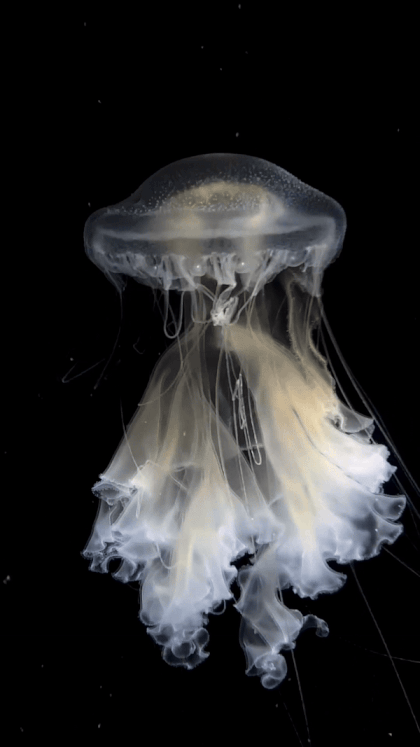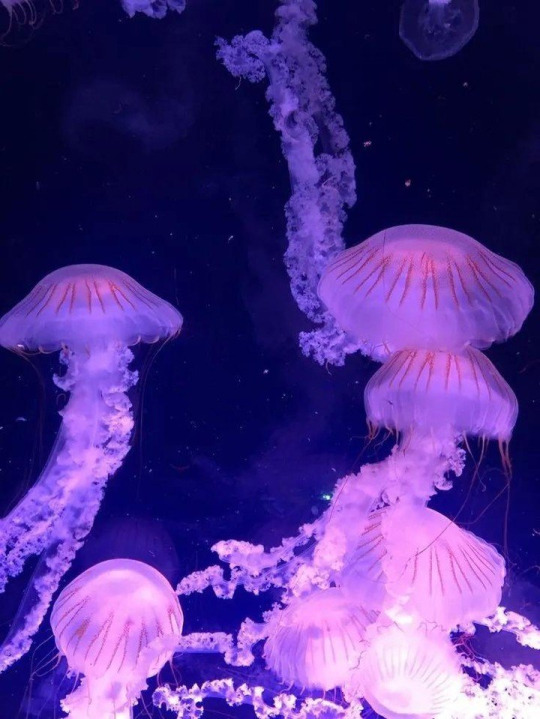Text
Cnidaria Fact #24: cnidarians always return when you need them the most
63 notes
·
View notes
Text
Moon jellyfish with pink lighting

Some sea jellies to make your day a little calmer
13 notes
·
View notes
Note
Just so you know: I'm pretty sure it'd be okay if you would want to scroll through the jellyfish tag and identify jellyfish even if you weren't tagged on a post! ^w^ [Though, if it isn't a bother for you, I would still like to tag you :D]
I don't have much free time these days unfortunately, which is why I only identify from tags for now- But you can absolutely go ahead and tag me in stuff !
3 notes
·
View notes
Text
Jellyfish identified !
Fried Egg Jellyfish - Phacellophora Camtschatica
BIOLOGY: This jellyfish has quite the debated classification. It was originally thought to be part of the Ulmaridae family (moon jellyfish), and then of the Cyaneidae family (lion's mane jellyfish); but was ultimately determined as part of a brand new family altogether: Phacellophoridae. However, that classification could change in the coming years. This species is also the sole known species in that family, but three or four more as suspected to exist: as such, the classification of the particular specimen in this post could be identified as incorrect when more light is shed on the matter.
That said, this species of jellyfish usually bears a yellow center with a translucent bell: earning it the name of fried-egg jellyfish. Although of course some individuals vary in color, being either nearly colorless or wholly yellow. They also have curtain-like oral arms, and a weak sting.
LOCATION: These jellies reside in cool waters, but aren't an extremely common sight. They have mainly been recorded in parts of the Sea of Japan and the Sea of Okhotsk, although they can be seen around the world.
SIZE: An adult specimen's bell can range from approx. 12 inches (60cm) with tentacles as long as 20 feet (6 meters).
GALLERY:







>> the_story_of_a_biologist
#jellyfish#jellyfish identified#jellyf id#fried egg jellyfish#phacellophora camtschatica#marine biology#marine life#sea life#ocean
15K notes
·
View notes
Text
Not-Jellyfish Identified !
Blue button - Porpita Porpita
BIOLOGY: These critters, despite looking very similar to jellyfish, are not ! They are a colony of hydrozoan polyps. See how coral works ? A colony of thousands of individuals working to create a functioning whole ? The same thing goes for these guys ! They're made of two parts: the float, a generally yellowish brown disc that serves to... well, float, and the actual colony, which constitutes the "tentacles". The ones in the video are babies, so it's hard to distinguish the different parts of the body - but they're more visible in the gallery part of this post.
They can sting, and even if it's only a mildly irritating sting, better safe than sorry - you never know if you'll be allergic to them. It's best not to pick them up if you see them washed up on shore.
LOCATION: These creatures can be found mostly in tropical waters: in the gulf of mexico, in the waters of australia and the indian ocean.
SIZE: Babies like the ones shown in the video are very tiny, but an adult colony usually has a float of about an inch (2.54 centimeters), and the length of the tentacles may vary.
GALLERY:





Via coralfish12g on instagram
#jellyfish identified#jellyf id#jellyfish#porpita porpita#blue button#blue button jellyfish#hydrozoan#marine biology#marine life#sea life
2K notes
·
View notes
Text

@styrofoamdoor hi!! just saw your post and realized i never really found out what type of jelly this is, all i know is that it might be in class cubozoa (ᗒᗣᗕ) ! !
#MY PLEASURE OP !!#this is like. my job 🫡#some jellies are really rare#but always cool to learn about !!
28 notes
·
View notes
Text
Jellyfish Identified !
Chirodectes Maculatus
BIOLOGY: This species is from a monospecific genus (genus containing only one species) of cubozoa (box jellyfish), Chirodectes. They have no common name as they are extremely rare. As all Cubozoans do, they have a box-shaped bell and tentacles sprouting from the four corners of said bell. Their sting hasn't been recorded.
LOCATION: This jellyfish species has had only two recorded sightings, one in 1997 and one in 2022. The former happened along the outer edge of the Great Barrier Reef off the coast of Australia, and the latter - which the picture in this post is from - in Papua New Guinea.
SIZE: Not much information is available on these creatures, but from what I could find, their bell is approximately 6 inches in height.
GALLERY: the only pictures available of this species are the ones from the 2022 sighting, which this post already has- so I'll leave you with some of the footage :)

@styrofoamdoor hi!! just saw your post and realized i never really found out what type of jelly this is, all i know is that it might be in class cubozoa (ᗒᗣᗕ) ! !
28 notes
·
View notes
Text
Jellyfish identified !
South American Sea Nettle – Chrysaora Plocamia
BIOLOGY: This jellyfish is part of the Sea Nettles (Chrysaora) genus. It has a very mild sting similar to that of a stinging nettle, which is where this genus of jellyfish gets its name.
LOCATION: It is found along the coasts of South America, from the Pacific coast of Peru along Chile down to the tip of the continent, with sightings in Argentina and a few records in Uruguay.
SIZE: Most mature individuals have a bell diameter of 10-16 inches, but it can reach up to 30 inches. Its tentacles can reach up to 12 feet long.
GALLERY:




pink jellyfish
101 notes
·
View notes
Text
Welcome, jellyfish fans and curious passerbys alike ! You can call me jello.
I identify jellyfish species in posts.
Feel free to tag me in any post with a jelly you're curious about !
My profile picture features a White-Spotted Jellyfish Phyllorhiza Punctata, and my favorite jellyfish of all time is the Giant Phantom Jellyfish Stygiomedusa Gigantea.
Thank you MBARI (Monterey Bay Aquarium Research Institute) for providing the world with so much jellyfish footage and pictures.

I am in no way a professional biologist, but I do have autism. That said, take all posts with a grain of salt and don't hesitate to tell me if you think I've made a mistake.
34 notes
·
View notes